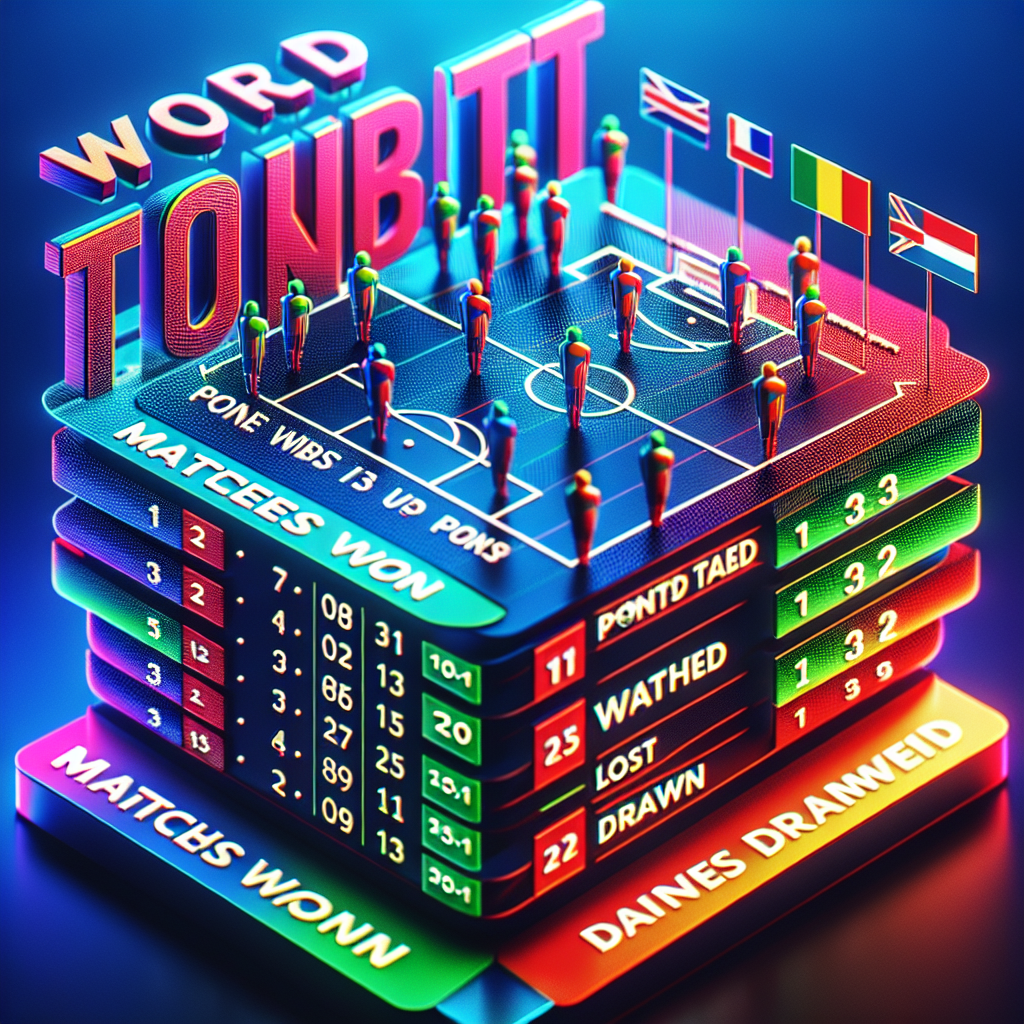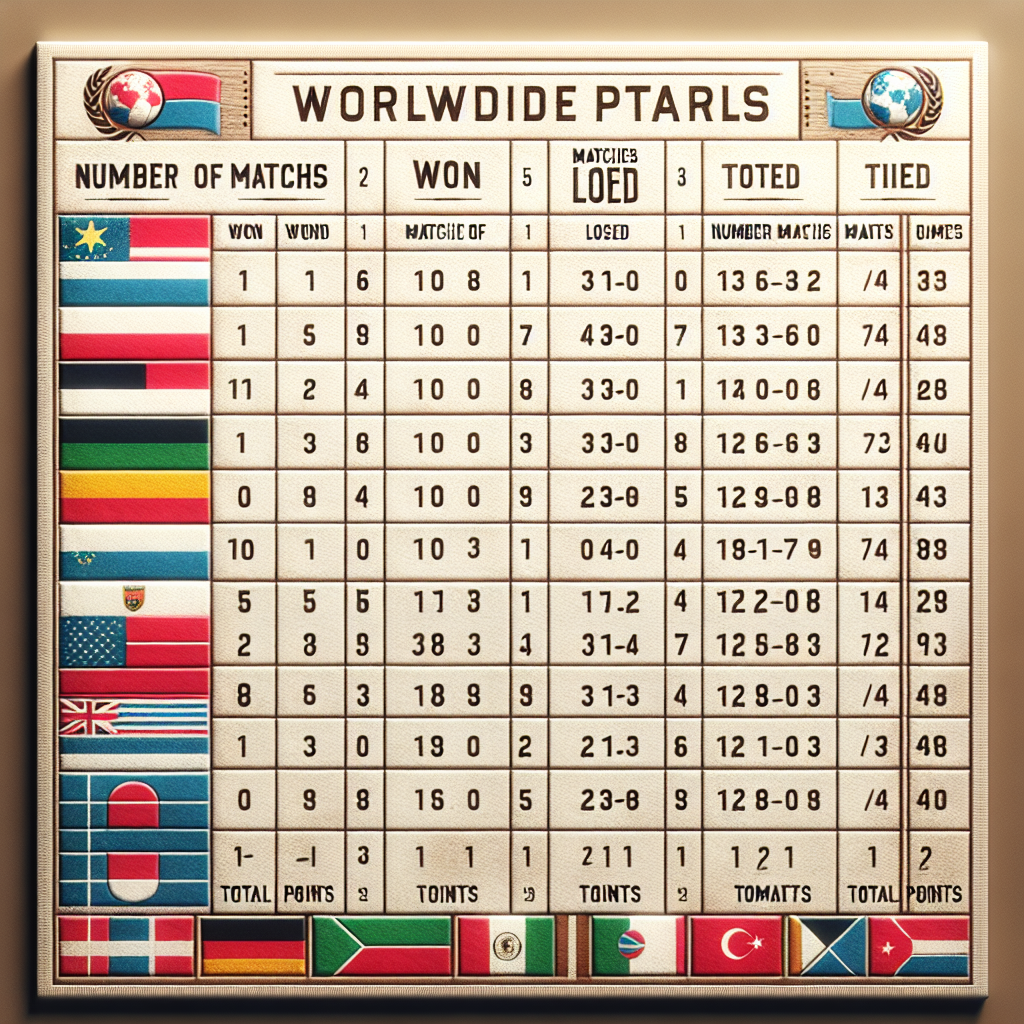
The Vishwa Cup, a term often used to refer to the Cricket World Cup in various regions, is one of the most anticipated sporting events globally. It brings together cricketing nations from around the world to compete for the prestigious title. A critical component of this tournament is the point table, which plays a pivotal role in determining which teams advance to the knockout stages. This article delves into the intricacies of the Vishwa Cup point table, offering insights into its structure, significance, and impact on the tournament's progression.
The Structure of the Vishwa Cup Point Table
The point table is a dynamic leaderboard that reflects the performance of each team throughout the tournament. It is updated after every match and serves as a real-time indicator of a team's standing. The table typically includes the following columns:
- Team: The name of the participating team.
- Matches Played (P): The total number of matches a team has played.
- Wins (W): The number of matches a team has won.
- Losses (L): The number of matches a team has lost.
- No Result (NR): Matches that ended without a result, often due to weather conditions.
- Points (Pts): The total points a team has accumulated. Typically, a win earns a team two points, a no-result earns one point, and a loss earns no points.
- Net Run Rate (NRR): A statistical measure used to break ties between teams with equal points. It is calculated based on the runs scored and conceded per over.
Significance of the Point Table
The point table is not just a reflection of wins and losses; it is a strategic tool that influences team strategies and fan expectations. Here are some reasons why the point table is significant:
- Determining Standings: The primary function of the point table is to rank teams based on their performance. The top teams advance to the knockout stages, making every match crucial.
- Strategic Decisions: Teams often make strategic decisions based on their position in the point table. For instance, a team with a low net run rate might focus on winning matches by larger margins to improve their standing.
- Fan Engagement: The point table keeps fans engaged by providing a clear picture of their favorite team's chances of advancing. It adds an element of suspense and excitement to the tournament.
Case Studies: Memorable Vishwa Cup Point Table Scenarios
2019 Cricket World Cup: New Zealand's Narrow Escape
The 2019 Cricket World Cup provided a thrilling example of how the point table can influence tournament outcomes. New Zealand and Pakistan were tied on points, but New Zealand advanced to the semi-finals due to a superior net run rate. This scenario highlighted the importance of not just winning matches but also maintaining a healthy run rate throughout the tournament.
1992 Cricket World Cup: The Introduction of the Round-Robin Format
The 1992 World Cup was the first to adopt a round-robin format, where each team played every other team. This format made the point table even more critical, as every match had a direct impact on the standings. Pakistan's remarkable comeback from the bottom of the table to eventually win the tournament is a testament to the unpredictability and excitement that the point table can bring.
Statistics and Trends: Analyzing Past Vishwa Cup Point Tables
Analyzing past point tables can provide valuable insights into trends and patterns that might influence future tournaments. Here are some key observations:
- Consistency is Key: Teams that consistently perform well in the group stages tend to advance further in the tournament. For instance, Australia has historically been a strong performer in the group stages, often finishing at the top of the point table.
- Impact of Weather: Weather conditions can significantly impact the point table, as seen in tournaments held in England. Matches affected by rain often result in no results, which can alter the standings unexpectedly.
- Importance of Net Run Rate: As seen in the 2019 World Cup, net run rate can be a decisive factor in breaking ties. Teams with a strong batting lineup often have an advantage in maintaining a high net run rate.
Strategies for Teams: Navigating the Point Table
Teams employ various strategies to navigate the complexities of the point table. Here are some common approaches:
- Focus on Winning Early Matches: Securing early wins can provide a buffer for teams, allowing them to experiment with strategies in later matches.
- Maintaining a Balanced Team: A balanced team with strong batting and bowling units can adapt to different match situations, improving their chances of winning consistently.
- Adapting to Conditions: Teams that adapt quickly to different pitch and weather conditions are often more successful in accumulating points.
Conclusion: The Point Table's Role in the Vishwa Cup
The Vishwa Cup point table is more than just a leaderboard; it is a dynamic and strategic element that shapes the tournament's narrative. From determining which teams advance to influencing strategic decisions, the point table is integral to the excitement and unpredictability of the Cricket World Cup. As fans and teams alike eagerly follow the standings, the point table remains a central focus, driving the drama and passion that make the Vishwa Cup a truly global spectacle.
In summary, understanding the point table's structure, significance, and impact can enhance one's appreciation of the tournament. Whether you're a seasoned cricket enthusiast or a casual fan, keeping an eye on the point table is essential to fully experiencing the thrill of the Vishwa Cup.

